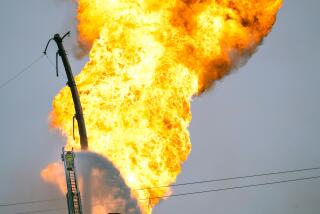Arkansas oil spill is only a fraction of annual pipeline losses
The images from Mayflower, Ark., after a March 29 oil spill were particularly repulsive: A river of black goo running through yards and down the street of a subdivision, and hundreds of workers arriving to clean up an industrial mess in a peaceful burg.
But the Exxon Mobil pipeline spill, initially estimated to have released at least 157,000 gallons of crude oil and driven more than 20 families from their homes, represents only a fraction of the regular oil losses from the huge network of pipelines stretching across the United States.
Between 2008 and 2012, U.S. pipelines spilled an average of more than 3.1 million gallons of hazardous liquids per year, according to data from the Pipeline & Hazardous Materials Safety Administration, the nation’s pipeline regulator. Those spills -- most commonly caused by corrosion and equipment failure -- caused at least $1.5 billion in property damage altogether.
In 2010, a historic inland spill of 819,000 gallons of diluted bitumen -- a kind of oil from the tar sands in Alberta -- shut down the Kalamazoo River for miles after a pipeline break in Marshall, Mich. Enbridge Inc., a Canadian pipeline company, ended up buying 150 homes from locals too unsettled by the disaster to return. That spill was overshadowed by the cataclysmic BP Horizon oil spill in the Gulf of Mexico, also in 2010.
The Mayflower spill, much smaller by comparison, has nonetheless spurred action from the Arkansas attorney general, who this week used a subpoena to compel Exxon Mobil to turn over 12,587 pages of documents, five CDs of data and 200 blueprint-sized diagrams related to the company’s Pegasus Pipeline and its spill.
Arkansas Atty. Gen. Dustin McDaniel has requested $4 million from Exxon to help pay the state’s investigative expenses for exploring why a 2-inch-wide, 22-foot-long crack developed in the pipeline -- which sits 2 feet underground and was capable of carrying up to 3 million gallons of oil a day from Illinois to Texas.
Exxon said Thursday the cause of the spill was still unknown and that officials were planning to excavate the damaged portion of the pipeline soon for further investigation. The company remains barred by regulators from reopening the pipeline until the company submits plans for further tests and evaluations.
A federal class-action lawsuit filed against Exxon by Mayflower residents alleges that the company “failed to inspect and maintain their unsafe and defective pipeline.” The residents’ attorneys, the Little Rock-based Duncan Firm, noted that the company had once violated federal regulations for not inspecting part of the 65-year-old pipeline for flaws between 2002 and 2010. The company paid a $26,200 fine as a result.
Exxon had inspected the portion of the pipeline that cracked in 2010 without finding flaws, but it was still awaiting the results of a February scan conducted on the same segment, according to the Pipeline & Hazardous Materials Safety Administration.
As of Thursday, Arkansas health officials had agreed to a plan to open 10 of the evacuated homes to residents, pending air-quality tests, if the residents want the tests. Exxon is paying for the cleanup and says it will honor residents’ claims for damages; 208 claims have already been filed.
Four snakes, 21 turtles and a toad were released back into the wild Thursday, and officials said about 27 animals were still being cleaned.
ALSO:
New Texas prosecutor appointed amid more alleged threats
2 robbers attack Chicago store, but owner fiercely fights back
Hermit in Maine woods for 27 years suspected in 1,000 burglaries
More to Read
Sign up for Essential California
The most important California stories and recommendations in your inbox every morning.
You may occasionally receive promotional content from the Los Angeles Times.











